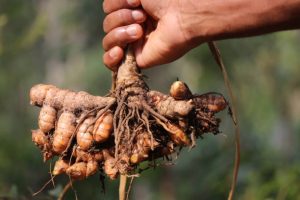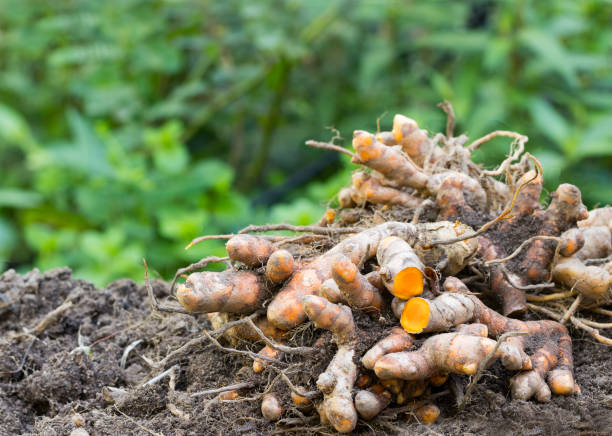Turmeric plant is akin to spicy plants or rhizomes like ginger, garlic, onion etc and it is native to Indian Subcontinent.
Turmeric belongs to the family Zingerabeceae, it is a perennial herbaceous plant also called Curcuma longa.
It also has high benefits to the human body but before we analyze those.
How are Turmeric Plant Grown?
Preparation of land

To grow a turmeric, the land needs to be prepared with the receipt of early showers where the soil is made to a fine tilth through four deep ploughings.
Hydrated lime @ 500 kg/ha has to be applied for laterite soils and thoroughly ploughed.
Immediately with the receipt of pre-monsoon showers, beds of 1.0 m width, 15 cm height and of convenient length are prepared with spacing of 50 cm between beds. Planting is also done by forming ridges and furrows.
In a place called Kerala and some West Coast areas where the rainfall begins early, the crop can be planted during April-May with the receipt of pre-monsoon showers.
It is best to bear in mind that Turmeric plant is much similar to ginger even in appearance and as a bonus they imitate nearly same planting methods.
Turmeric doesn’t have typical tiny “seeds” that you imagine for most plants. Instead, pieces of the root system called rhizomes are planted, which in turn produce above-ground foliage as well as more, larger rhizomes
Seed material
Whole or split mother and finger rhizomes are used for planting and well developed healthy and disease free rhizomes are to be selected.
Small pits are made with a hand hoe on the beds with a spacing of 25 cm x 30 cm.
Pits are filled with well decomposed cattle manure or compost, seed rhizomes are placed over it then covered with soil.
The optimum spacing in furrows and ridges is 45-60 cm between the rows and 25 cm between the plants.
A seed rate of 2,500 kg of rhizomes is required for planting one hectare of turmeric.
Harvesting of Turmeric Plant

Depending upon the variety, the crop becomes ready for harvest in 7-9 months after planting during January-March.
Early varieties mature in 7-8 months, medium varieties in 8-9 months and late varieties after 9 months.
The land is ploughed and the rhizomes are gathered by hand picking or the clumps are carefully lifted with a spade.
The harvested rhizomes are cleared of mud and other extraneous matter adhering to them.
Curing
Fresh turmeric is cured for obtaining dry turmeric. The fingers are separated from mother rhizomes. Mother rhizomes are usually kept as seed material.
Curing involves boiling of fresh rhizomes in water and drying in the sun.
In the traditional method of curing, the cleaned rhizomes are boiled in water just enough to immerse them.
Boiling is stopped when froth comes out and white fumes appear giving out a typical odour.
The boiling should last for 45-60 minutes when the rhizomes turn soft. The stage at which boiling is stopped largely influences the colour and aroma of the final product.
Over cooking spoils the colour of the final product while under-cooking renders the dried product brittle.
Manuring and fertilizer Application
Farmyard manure (FYM) or compost @ 30-40 t/ha is applied by broadcasting and ploughed at the time of preparation of land or as basal dressing by spreading over the beds or in to the pits at the time of planting.
Fertilizers @ 60 kg N, 50 kg P2O5 and 120 kg K2O per hectare are to be applied in split doses as given in Table 2. Zinc @ 5 kg/ha may also be applied at the time of planting and organic manures like oil cakes can also be applied @ 2 t/ha.
In such case, the dosage of FYM can be reduced. Integrated application of coir compost (@ 2.5 t/ha) combined with FYM, biofertilizer (Azospirillum) and half recommended dose of NPK is also recommended.
Benefits and Wonders of Turmeric Plants
Turmeric provide lots of medicinal help due to its rich compounds that help mitigate against diseases and infections.
Some of these diseases it caters to include:
- Rheumatoid arthritis
- Chronic anterior uveitis
- Conjunctivitis
- Skin cancer, small and chicken pox, urinary tract infections, liver ailments and more.
Conclusion
Turmeric plant are easy to cultivate once the healthy ones are skillfully selected for the purpose.
Its health benefits makes it a delight and a wonder as well as its yielding abilities which is impressive.
